instrument panel Citroen JUMPY MULTISPACE 2010 2.G User Guide
[x] Cancel search | Manufacturer: CITROEN, Model Year: 2010, Model line: JUMPY MULTISPACE, Model: Citroen JUMPY MULTISPACE 2010 2.GPages: 235, PDF Size: 11.2 MB
Page 47 of 235

42
Steering mounted controls
CRUISE CONTROL "CRUISE"
In order for it to be programmed or activated,
the vehicle speed must be greater than
25 mph (40 km/h) with at least 4th gear
engaged. Function selected,
displaying of the "Cruise
Control" symbol.
Function deactivated,
OFF (example at
107 km/h).
Function activated
(example at 107 km/h).
Vehicle speed above
(e.g. 118 km/h),
the programmed speed
is displayed flashing.
Operating fault detected,
OFF - the dashes flash.
This cruise control shows the function
selection status on the instrument panel and
displays the programmed speed:
"This is the speed at which the driver wishes
to drive".
This aid to driving in free-flowing traffic
enables the vehicle to maintain the speed
programmed by the driver, unless a steep
gradient makes this impossible.
Page 50 of 235
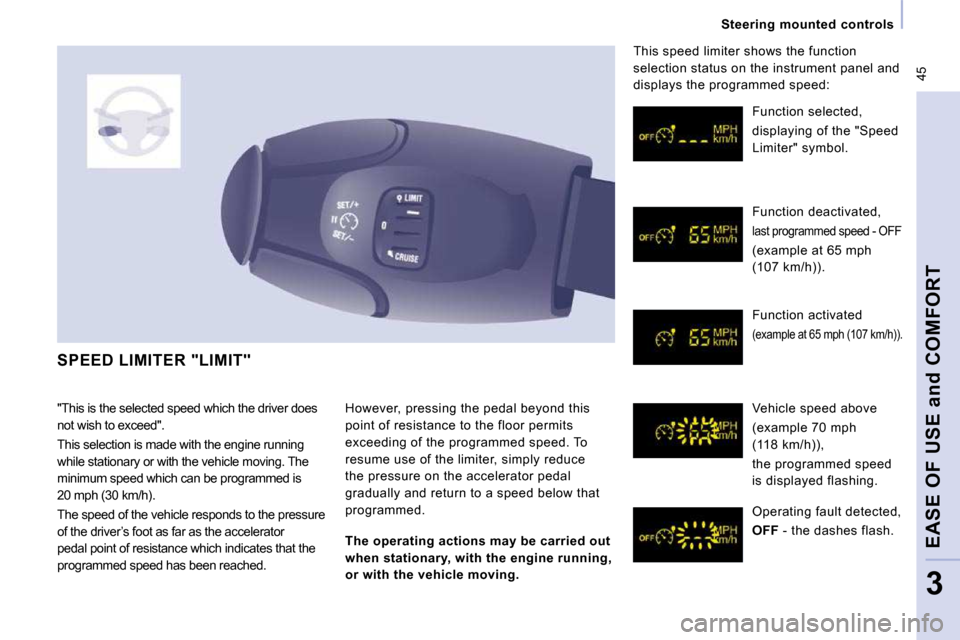
45
Steering mounted controls
EASE OF USE and COMFORT
3
SPEED LIMITER "LIMIT"
However, pressing the pedal beyond this
point of resistance to the floor permits
exceeding of the programmed speed. To
resume use of the limiter, simply reduce
the pressure on the accelerator pedal
gradually and return to a speed below that
programmed. Function selected,
displaying of the "Speed
Limiter" symbol.
Function deactivated,
last programmed speed - OFF
(example at 65 mph
(107 km/h)).
Function activated
(example at 65 mph (107 km/h)).
Vehicle speed above
(example 70 mph
(118 km/h)),
the programmed speed
is displayed flashing.
Operating fault detected,
OFF - the dashes flash.
This speed limiter shows the function
selection status on the instrument panel and
displays the programmed speed:
The operating actions may be carried out
when stationary, with the engine running,
or with the vehicle moving.
"This is the selected speed which the driver does
not wish to exceed".
This selection is made with the engine running
while stationary or with the vehicle moving. The
minimum speed which can be programmed is
20 mph (30 km/h).
The speed of the vehicle responds to the pressure
of the driver’s foot as far as the accelerator
pedal point of resistance which indicates that the
programmed speed has been reached.
Page 77 of 235
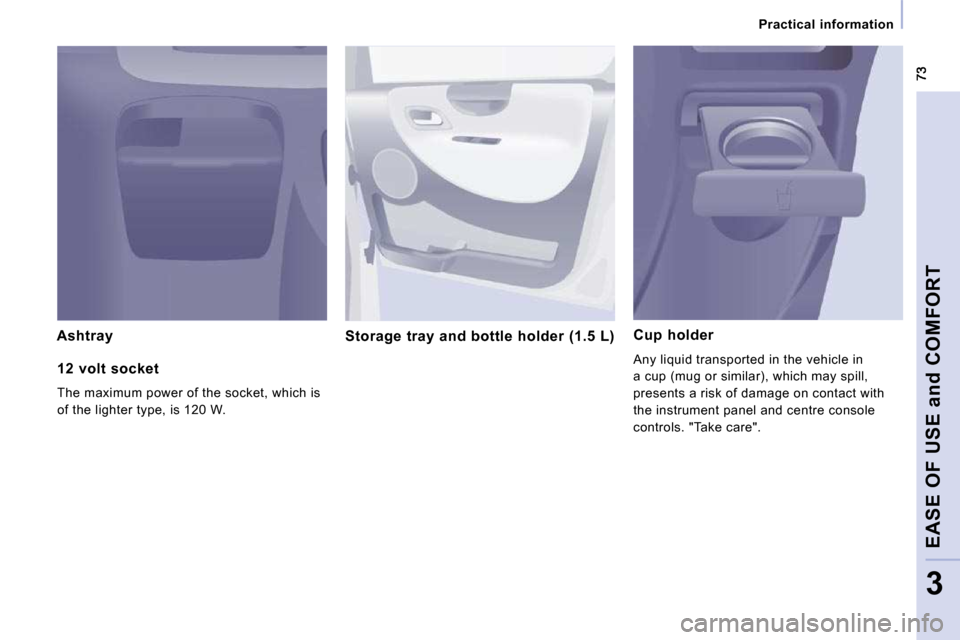
Practical information
EASE OF USE and COMFORT
3
Ashtray Storage tray and bottle holder (1.5 L) Cup holder
Any liquid transported in the vehicle in
a cup (mug or similar), which may spill,
presents a risk of damage on contact with
the instrument panel and centre console
controls. "Take care". 12 volt socket
The maximum power of the socket, which is
of the lighter type, is 120 W.
Page 90 of 235

85
Driving safely
SAFETY
4
PARKING BRAKE When parking on a slope, direct your wheels
towards the pavement and pull the parking
brake lever up.
There is no advantage in engaging a gear
after parking the vehicle, particularly if the
vehicle is loaded. HAZARD WARNING LAMPS
Press this button, the direction indicators
flash.
They can operate with the ignition off.
The hazard warning lamps should only be
used in dangerous situations, when stopping
in an emergency or when driving in unusual
conditions.
DRIVING SAFELY
Applying
Pull the parking brake to immobilise your
vehicle.
Check that the parking brake is applied
firmly before leaving the vehicle. If the parking brake is still on or has
not been released properly, this is
indicated by this warning lamp which
comes on on the instrument panel.
Releasing
Pull the lever and press the button to lower
the parking brake lever.
Page 98 of 235

95
Airbags
SAFETY
4
Disarming
The passenger's front airbag alone can be
disarmed:
- With the ignition switched off , insert
the key into the passenger airbag
disarming switch,
- turn it to the "OFF" position,
- then remove the key keeping the slot in this position. Front airbags
The front airbags are incorporated in the
centre of the steering wheel for the driver
and in the fascia for the front passenger. Reactivation
In the
"OFF" position, the passenger airbag
will not be triggered in the event of an impact.
As soon as the child seat is removed, turn
the airbag slot to the "ON" position to
re-activate the airbag and thus ensure the
safety of your passenger in the event of an
impact. To ensure the safety of your child, it
is essential to disarm the passenger
airbag when you install a rear-facing child
seat on the front passenger seat. Otherwise,
the child would risk being killed or seriously
injured if the airbag were to inflate.
The airbag warning light on the
instrument panel is lit throughout
the period of disarming.
Activation
They are deployed simultaneously, unless the
passenger's front airbag has been disarmed,
in the event of a serious front impact applied
to all or part of the front impact zone
A in
the longitudinal centreline of the vehicle on
a horizontal plane directed from the front
towards the rear of the vehicle.
The front airbag inflates between the front
occupant of the vehicle and the fascia to
cushion his forward movement. Front airbag fault
If this warning light comes on,
accompanied by an audible signal
and a message on the display,
contact a CITROËN dealer to
have the system checked.
If the two airbag warning lights are lit
continuously, do not install a rear-facing
child seat. Consult a CITROËN dealer.
Page 101 of 235
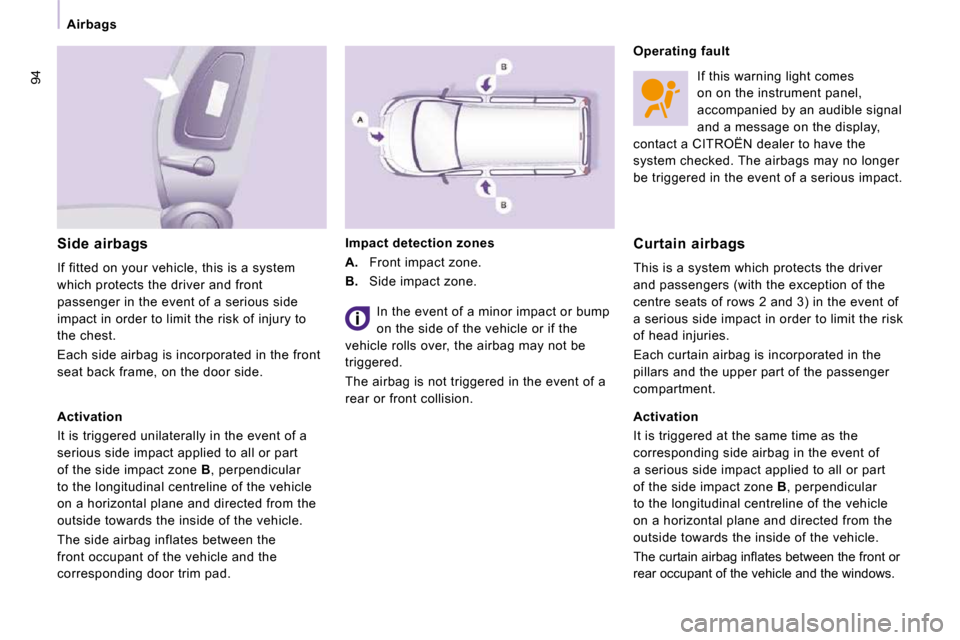
94
Airbags
Side airbags
If fitted on your vehicle, this is a system
which protects the driver and front
passenger in the event of a serious side
impact in order to limit the risk of injury to
the chest.
Each side airbag is incorporated in the front
seat back frame, on the door side. Impact detection zones
A. Front impact zone.
B. Side impact zone. If this warning light comes
on on the instrument panel,
accompanied by an audible signal
and a message on the display,
contact a CITROËN dealer to have the
system checked. The airbags may no longer
be triggered in the event of a serious impact.
Activation
It is triggered unilaterally in the event of a
serious side impact applied to all or part
of the side impact zone B , perpendicular
to the longitudinal centreline of the vehicle
on a horizontal plane and directed from the
outside towards the inside of the vehicle.
The side airbag inflates between the
front occupant of the vehicle and the
corresponding door trim pad.
Curtain airbags
This is a system which protects the driver
and passengers (with the exception of the
centre seats of rows 2 and 3) in the event of
a serious side impact in order to limit the risk
of head injuries.
Each curtain airbag is incorporated in the
pillars and the upper part of the passenger
compartment.
Activation
It is triggered at the same time as the
corresponding side airbag in the event of
a serious side impact applied to all or part
of the side impact zone B , perpendicular
to the longitudinal centreline of the vehicle
on a horizontal plane and directed from the
outside towards the inside of the vehicle.
� �T�h�e� �c�u�r�t�a�i�n� �a�i�r�b�a�g� �i�n�fl� �a�t�e�s� �b�e�t�w�e�e�n� �t�h�e� �f�r�o�n�t� �o�r�
rear occupant of the vehicle and the windows.
In the event of a minor impact or bump
on the side of the vehicle or if the
vehicle rolls over, the airbag may not be
triggered.
The airbag is not triggered in the event of a
rear or front collision. Operating fault
Page 116 of 235
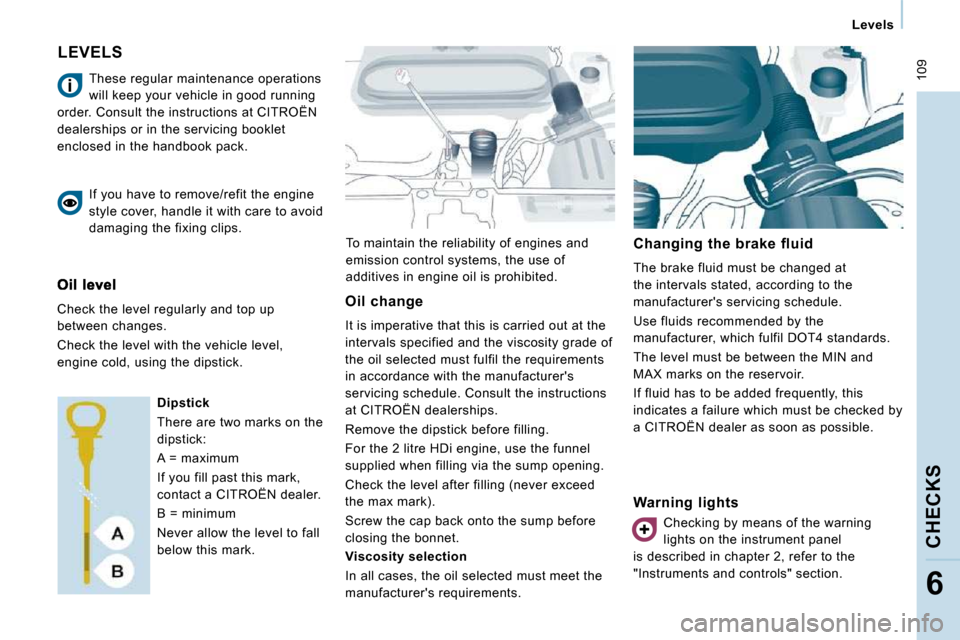
109
Levels
CHECKS
6
LEVELS
To maintain the reliability of engines and
emission control systems, the use of
additives in engine oil is prohibited. Changing the brake fluid
The brake fluid must be changed at
the intervals stated, according to the
manufacturer's servicing schedule.
Use fluids recommended by the
manufacturer, which fulfil DOT4 standards.
The level must be between the MIN and
MAX marks on the reservoir.
If fluid has to be added frequently, this
indicates a failure which must be checked by
a CITROËN dealer as soon as possible.
These regular maintenance operations
will keep your vehicle in good running
order. Consult the instructions at CITROËN
dealerships or in the servicing booklet
enclosed in the handbook pack.
If you have to remove/refit the engine
style cover, handle it with care to avoid
damaging the fixing clips.
Check the level regularly and top up
between changes.
Check the level with the vehicle level,
engine cold, using the dipstick. Dipstick
There are two marks on the
dipstick:
A = maximum
If you fill past this mark,
contact a CITROËN dealer.
B = minimum
Never allow the level to fall
below this mark. Oil change
It is imperative that this is carried out at the
intervals specified and the viscosity grade of
the oil selected must fulfil the requirements
in accordance with the manufacturer's
servicing schedule. Consult the instructions
at CITROËN dealerships.
Remove the dipstick before filling.
For the 2 litre HDi engine, use the funnel
supplied when filling via the sump opening.
Check the level after filling (never exceed
the max mark).
Screw the cap back onto the sump before
closing the bonnet.
Viscosity selection
In all cases, the oil selected must meet the
manufacturer's requirements.
Warning lights
Checking by means of the warning
lights on the instrument panel
is described in chapter 2, refer to the
"Instruments and controls" section.
Page 138 of 235
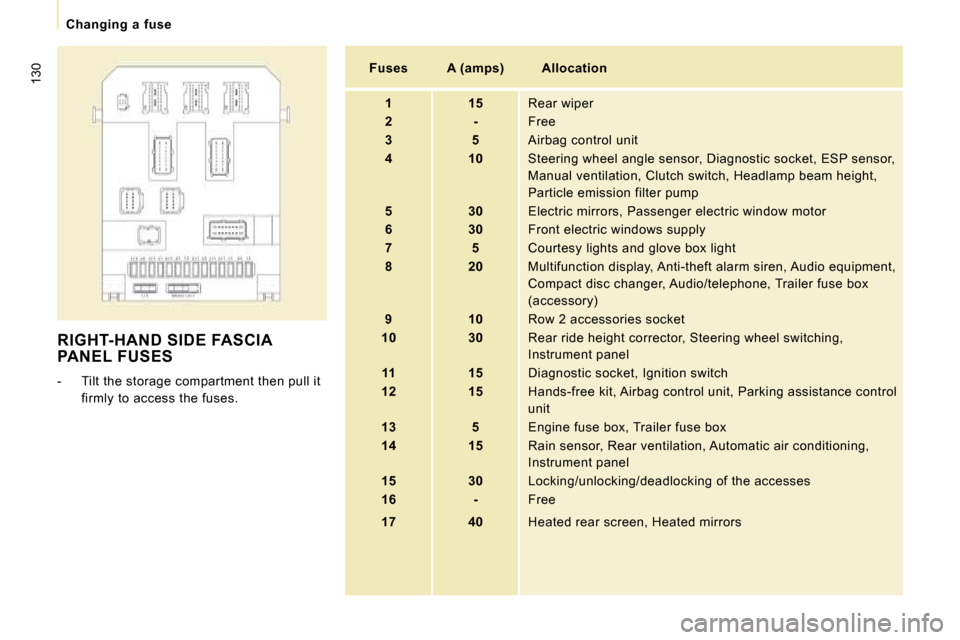
130
Changing a fuse
RIGHT-HAND SIDE FASCIA PANEL FUSES
- Tilt the storage compartment then pull it firmly to access the fuses.
Fuses A (amps) Allocation
1 15 Rear wiper
2 - Free
3 5 Airbag control unit
4 10 Steering wheel angle sensor, Diagnostic socket, ESP sensor,
Manual ventilation, Clutch switch, Headlamp beam he ight,
Particle emission filter pump
5 30 Electric mirrors, Passenger electric window mot or
6 30 Front electric windows supply
7 5 Courtesy lights and glove box light
8 20 Multifunction display, Anti-theft alarm siren, Audio equipment,
Compact disc changer, Audio/telephone, Trailer fuse box
(accessory)
9 10 Row 2 accessories socket
10 30 Rear ride height corrector, Steering wheel swit ching,
Instrument panel
11 15 Diagnostic socket, Ignition switch
12 15 Hands-free kit, Airbag control unit, Parking as sistance control
unit
13 5 Engine fuse box, Trailer fuse box
14 15 Rain sensor, Rear ventilation, Automatic air co nditioning,
Instrument panel
15 30 Locking/unlocking/deadlocking of the accesses
16 - Free
17 40 Heated rear screen, Heated mirrors